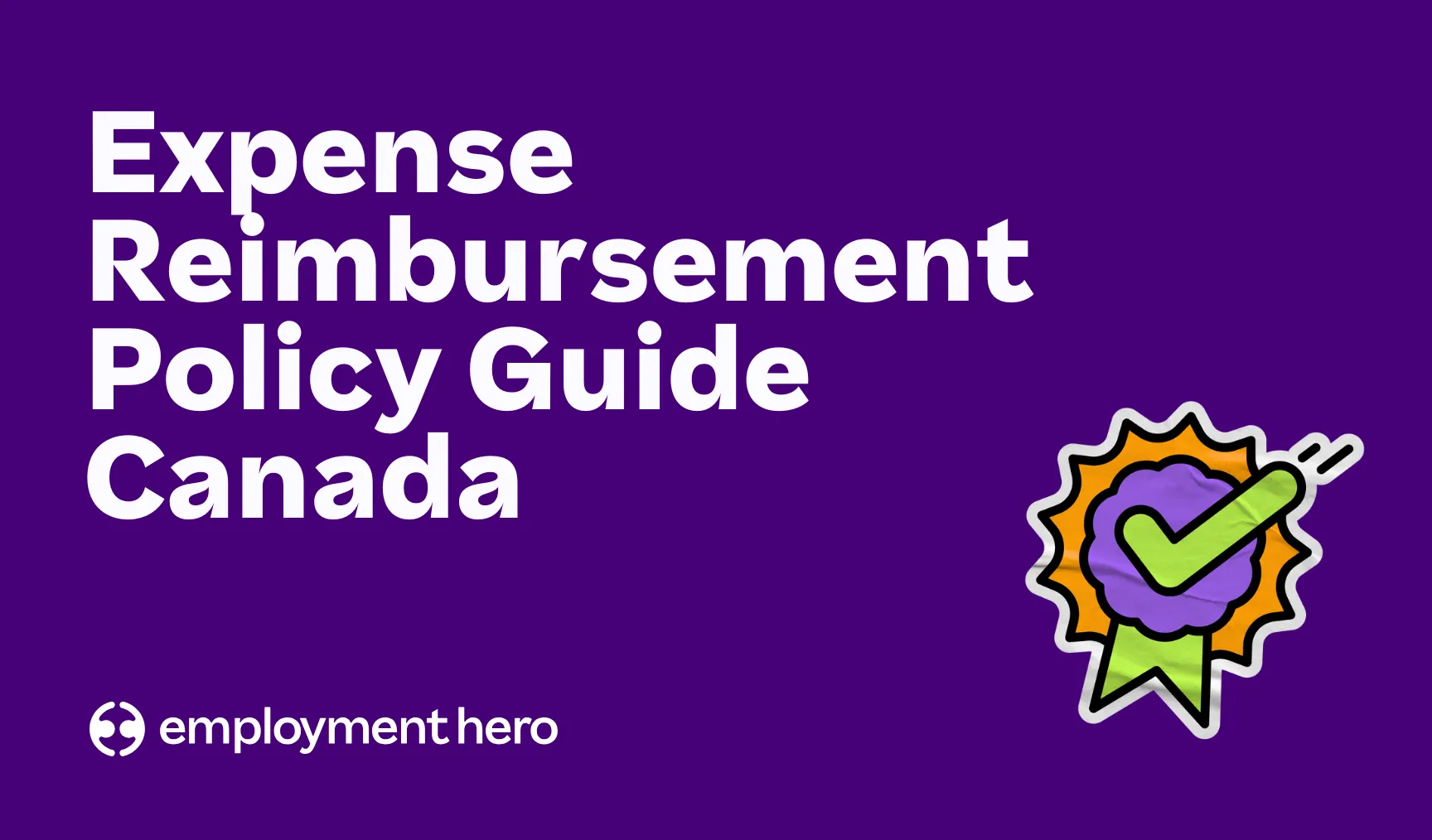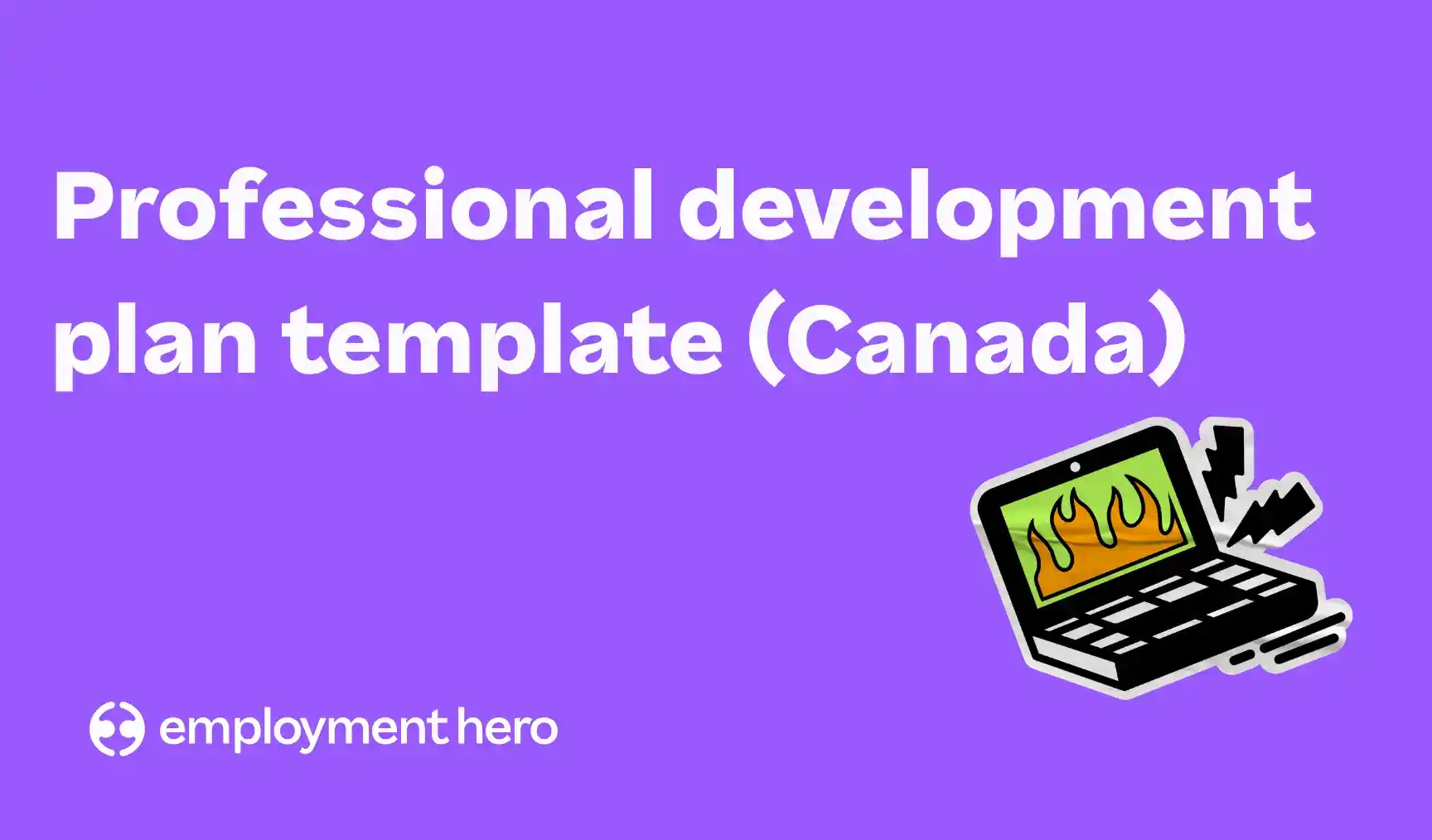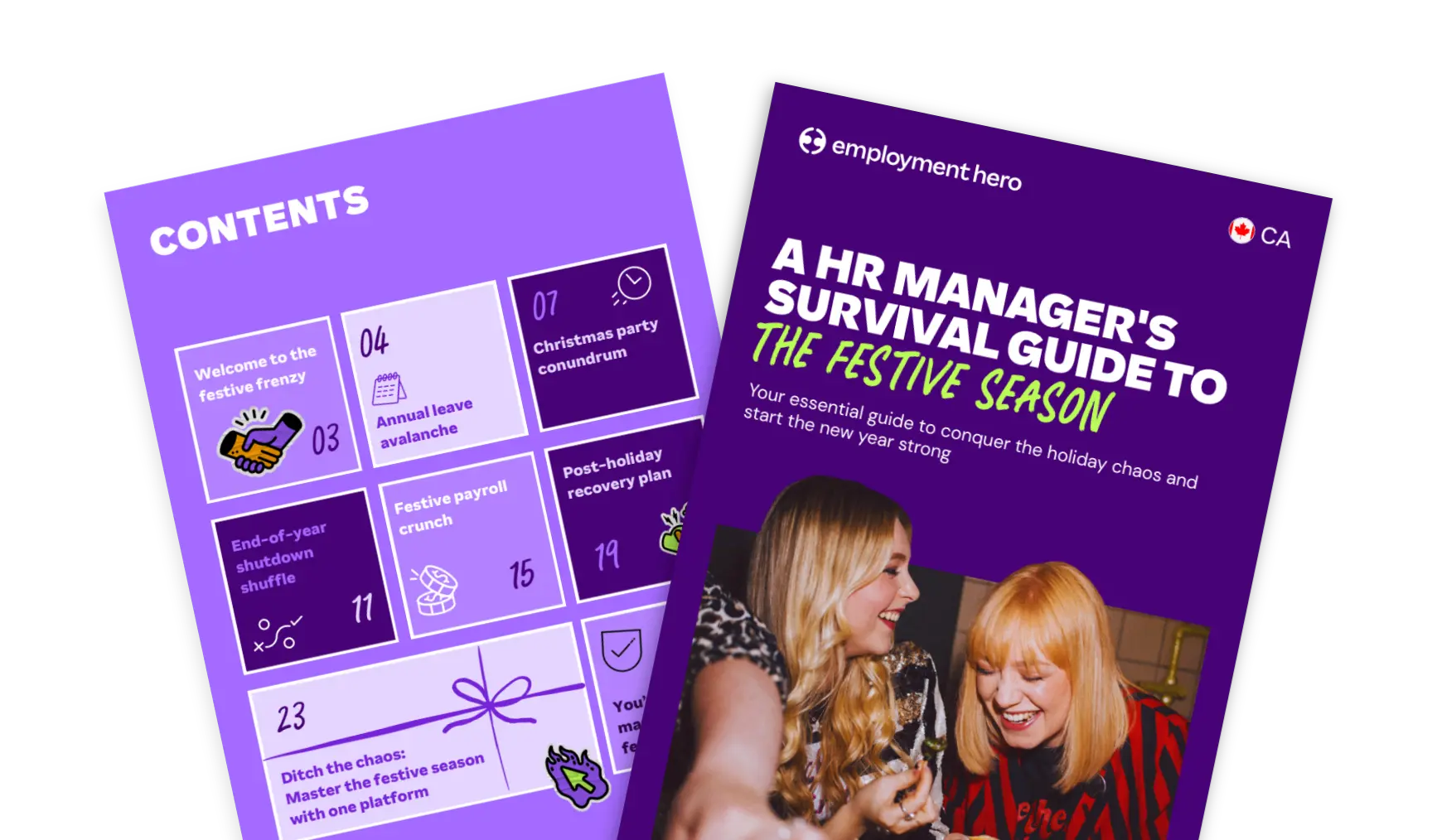Guide to HR: What every Canadian employer needs to know
Published
Guide to HR: What every Canadian employer needs to know
Published
If you’re running a business in Canada, you’re already aware of the complexities of HR (Human Resources) and compliance. If the overwhelming paperwork is keeping you up at night, you’re not alone. You wear many hats, and trying to keep up with shifting provincial minimum wages, deciphering OHS (Occupational Health and Safety) mandates, or ensuring your employment contracts are truly ironclad often falls to the bottom of the list. If you feel like navigating HR is a continuous game of legal whack-a-mole, you’re in the same boat as most business owners.
But here is the strategic truth: HR compliance is more than just avoiding fines; it is the foundation of your future success. The rules—covering everything from fairness to safety—are the blueprint for a productive, resilient workplace culture. Proactive compliance allows you to recognize and resolve HR mistakes before they escalate into costly legal claims, freeing you to focus on growth. This comprehensive guide breaks down the core HR requirements and best practices that Canadian employers must implement to ensure that their business and their employees are set up for success.
What is covered in this guide?
This guide is your tactical roadmap, detailing the five pillars of Canadian HR compliance that define your operational vulnerability: employment standards (wages, hours, leave), Occupational Health and Safety (keeping people safe and avoiding criminal liability), human rights (fairness and accommodation), the employee lifecycle (hiring to termination) and risk mitigation (policies, technology and legal defense).
What is HR compliance?
HR compliance is the mandatory adherence to the vast, interlocking network of federal, provincial and territorial laws that govern every facet of employment in Canada.
Compliance is not just paperwork; it is the embodiment of due diligence. In court, your efforts to comply are your defense. If you fail to demonstrate that you took every reasonable step to follow the law, the consequences—from administrative penalties to devastating civil damages—can be swift and severe.
Risks of non-compliance
- Crippling financial penalties: Government agencies (e.g., Ministries of Labour) issue administrative penalties that escalate with every repeat offense. Provincial OHS fines for serious violations can soar into the hundreds of thousands of dollars, especially if a fatality occurs.
- Wrongful dismissal judgments: Canada has no “at-will” employment. A single defect in a termination clause of an employment contract can render it void, exposing the employer to months or even years of salary payouts, even if they paid the statutory minimum.
- Reputational damage and loss of trust: Non-compliant employers are often named on public registries, destroying their employer brand and talent pipeline.
- Director and officer liability: In serious OHS or environmental cases, individual executives and corporate officers can be held personally liable under the Criminal Code (often referred to as Bill C-45 liability).
What’s the difference between an act and a regulation?
Canada’s employment law operates like a layered structure. Understanding the distinction between an Act and a Regulation is key to interpreting legal counsel.
| Layer | Term | Function | Example |
|---|---|---|---|
| Foundation | Act (or Statute) | A primary law created by a legislature (Parliament or a provincial assembly). It establishes a broad legal framework, principles, and fundamental requirements. | The Canada Labour Code (Federal), the Employment Standards Act (e.g., in Ontario) or Bill 96, which is an act respecting French, the official and common language of Québec |
| Blueprint | Regulation | Subordinate legislation that provides the detailed, specific rules and procedures necessary to carry out and enforce the broader provisions of an Act. Regulations often include specific thresholds, forms or technical specifications. | Regulations made under the Canada Labour Code that specify the exact minimum vacation pay percentages or the detailed safety procedures for specific industries. |
Workforce standards and requirements
The Golden Rule of Canadian HR: Employee rights, wages and leave entitlements are primarily controlled at the provincial or territorial level. Remember to adhere to the legislation specific to your employee’s physical work location. Compliance means never falling below this legislated minimum standard.

| Standard area | The legal mandate (what’s required) | The risk of failure |
|---|---|---|
| Hours and overtime | Maximum daily/weekly hours, mandatory rest breaks and overtime pay (typically 1.5× regular rate) calculated after a specific threshold (e.g., 44 hours). | Large-scale class-action lawsuits over miscalculated overtime are a growing liability. |
| Job-protected leave | Mandatory time off for sickness, family care, bereavement and parental leave. These leaves are protected; the employee must be returned to their same or a comparable job. | Denial or retaliation for taking a protected leave is a direct violation, leading to significant damages. |
| Vacation and public holidays | Minimum paid vacation time and pay rates, along with a list of mandated statutory paid holidays. | Failure to accurately track and remit the required minimum vacation pay percentage leads to back-pay orders. |
| Termination notice and Pay in lieu | Provincial employment standards laws require employers to provide minimum written notice or pay in lieu when ending employment and this applies to both hourly and salaried employees, including those on probation unless properly exempted in a compliant contract. | If an employer only pays the minimum or skips notice without a legally enforceable contract, employees can pursue Common Law damages, leading to severance costs far beyond provincial minimums, often months of additional pay. Wrongful dismissal claims are one of the most expensive risks for SMBs. |
| Basic Safety Training (OHS Awareness, WHMIS, Hazard Reporting) | All provinces require employers to train every employee (even remote) on health and safety rights, hazard reporting procedures, and WHMIS if any controlled products are present (including toner, cleaning wipes, sanitizer). Documentation is required. | Inspectors can issue orders or fines if training records can’t be produced. White-collar businesses are increasingly being inspected in Ontario, BC, Alberta and Quebec. |
| Workplace Harassment & Violence Policy + Training | Separate from general safety training, all provinces and territories require employers to have a workplace harassment and violence policy and to ensure employees are trained on how to recognize and report incidents. Most small businesses believe policy posting or committee rules don’t apply to them yet but regulators make it clear: prevention and training obligations begin at the moment you employ your first person. | If a harassment complaint is made and the employer cannot show a policy AND proof of training, regulators can issue compliance orders or human rights claims may escalate. |
Workplace safety and health protection
Occupational Health and Safety (OHS) laws are arguably the most critical and serious area of compliance for Canadian employers. Unlike violations of employment standards, a severe OHS breach can be a criminal matter, exposing both the company and individual directors, officers and supervisors to massive fines and even jail time under the Criminal Code (often referred to as Bill C-45 liability).
Even issues like inadequate or improper workplace lighting is a frequently cited hazard. which demonstrates how the OHS obligation extends even to the mundane details of the workplace. Regulators across Canada require employers to ensure lighting is sufficient to enable work to be done safely and that glare and shadows are minimized.
The primary objective of OHS legislation is the prevention of injury and illness, achieved through the robust and mandatory framework known as the Internal Responsibility System (IRS).
The Internal Responsibility System (IRS)
Canadian OHS is founded on the IRS. The IRS is the principle that everyone in the workplace—from the CEO to the newest employee—is directly responsible for health and safety within their respective roles. It operates on the premise that the people closest to the hazard are best equipped to identify and control it. Safety is a shared, continuous obligation for everyone, but the employer holds ultimate accountability.
Employer obligations
- Due diligence: The legal gold standard. Employers must prove they took every reasonable precaution to protect workers.
- Joint health and safety committees (JHSC): Mandated for workplaces over a certain size. These committees, composed of worker and management representatives, are central to the employer’s due diligence defense.
- Hazard identification: The ongoing duty to assess, control and communicate workplace hazards.
We’ve gone over the basics of HR compliance but there’s so much more to learn about mastering HR compliance. Download this comprehensive guide to learn all about HR compliance at your own pace!
Hazardous materials management systems
If you handle any hazardous products, WHMIS (Workplace Hazardous Materials Information System) compliance is mandatory and non-negotiable.
WHMIS mandates:
- Labels: Ensuring every hazardous container has a clear, compliant label.
- Safety Data Sheets (SDS): Providing immediate, accessible SDSs for all products—these are the “owner’s manuals” for dangerous substances.
- Worker education: Training workers on the specific hazards, safe handling procedures and emergency response for every product in the workplace.
Workers’ safety rights and protections
To empower the IRS, workers have three fundamental, non-waivable rights:
- The right to know: Workers must be informed of all known workplace hazards.
- The right to participate: Workers have the right to participate in OHS decision-making (via JHSC or as a representative).
- The right to refuse unsafe work: An employee’s ultimate protection. They have the right to refuse work if they have reasonable cause to believe it poses a danger to themselves or others. This triggers a formal investigation process that must be meticulously followed by the employer.
Additional safety compliance requirements
Safety compliance is specialized by sector:
- Construction: Specialized training (e.g., fall protection certification), daily inspections and compliance with regulations for specific high-risk equipment.
- Healthcare: Strict adherence to protocols for infectious materials, sharps management and the protection of workers from patient violence.
- Manufacturing: Focus on machine guarding, energy isolation procedures (Lockout/Tagout) and mitigating repetitive strain injury risks.
HR compliance through the employee lifecycle
Every step of the employment relationship creates legally binding documentation and establishes expectations.
Compliance around hiring
The hiring process is governed by Human Rights Codes.
- Fair recruitment: Job criteria must be strictly limited to Bona Fide Occupational Requirements (BFOR). Any requirement that screens out a protected group (e.g., physical stature, youth) must be proven to be absolutely necessary for safe and effective job performance.
- Interview standards: Interview questions cannot probe protected grounds (e.g., family plans, religion, origin). Focus solely on skills, experience and the ability to perform the job’s essential duties.
Compliance around onboarding
The first 90 days are the most crucial time at the company for any employee. This is where the legal relationship is solidified.
- Mandatory training: Initial OHS, WHMIS and harassment training must be conducted and documented before the employee begins work or exposure.
- The paper trail: Ensuring all necessary tax forms (TD1), banking information and proof of eligibility to work in Canada are collected and verified.
It’s a common assumption that a 3-month probation period means they can terminate freely without documentation but that’s a misconception.
Employment standards laws still apply during probation. While most provinces allow termination without notice within the first 3 months, employers are still expected to:
- Document performance issues or reasons for termination
- Apply policies fairly and consistently
- Avoid terminating for discriminatory or retaliatory reasons (protected under human rights law)
If no documentation exists, the employer is more exposed to claims of wrongful dismissal, discrimination or constructive dismissal even during probation.
Probation reduces notice obligations, but it does not remove the duty to act fairly and keep records.
Employment contracts
A written employment contract is the employer’s first line of defence against common law wrongful dismissal claims. It must:
- Define terms: The contract must clearly and unambiguously define the employee’s entitlement to notice/severance upon termination and confirm that this entitlement meets or exceeds the minimums of the applicable employment standards legislation.
- Limit liability: Include a termination clause that explicitly limits the employee’s notice or pay-in-lieu entitlement to the minimums required by the applicable federal or provincial employment standards legislation. If this clause fails to meet the minimum standards, courts will void it, leaving the employer exposed to much higher common law damages.
At Employment Hero, we offer a range of free and customizable policies and templates that you can edit and use to suit your business needs. For example – our casual employment contract covers what a typical casual employment contract consists of, when you should use this template and a downloadable template that you can customize and put to use right away. Similarly, our termination letter template is designed to help you communicate essential information clearly, professionally and in line with relevant provincial employment standards.
HR documents
Legislation mandates the creation and retention of specific employment records:
- Job descriptions: Essential for performance management and human rights accommodation analysis.
- Payroll records: Detailed records of hours worked, pay rates, vacation accrual and deductions, typically required for a period of several years (e.g., 3-7 years depending on the province).
- Training and safety records: Proof of all mandatory training (OHS, WHMIS, harassment), crucial evidence in the event of an incident or litigation.
Employment statements for new hires
Solidifying the legal relationship requires employers to fulfill their duty to inform by formally providing specific, legally mandated information and rights to every new employee.
- Written statement detailing job title, pay rate and pay period: This document, often required to be provided within a specific timeframe (e.g., 30 days federally), formally communicates the essential terms of the employment. It must specify the employee’s starting wage, the method of payment (hourly/salary), the frequency and timing of paydays, and a general description of their anticipated duties and hours of work, ensuring clarity on core statutory entitlements.
- Displaying or distributing mandatory government posters outlining minimum employee rights under employment standards legislation: Employers are legally required to post or make readily accessible government-issued documents in conspicuous workplace locations. These posters detail critical employee protections under various provincial acts, most commonly covering Employment Standards (e.g., termination notice, minimum wage) and Occupational Health and Safety (e.g., the right to refuse unsafe work and OHS committee structure).

Employee handbooks and mandatory policies
Employee handbooks serve as a centralized source of rules and are often legally required. Policies must be tailored to the province(s) or territories of operation. Some of the suggested policies include:
- Workplace harassment and violence policy: Legally mandatory across all jurisdictions, defining the process for reporting, investigating and addressing incidents.
- Accessibility policies: Required under federal law (Accessible Canada Act) and provincial laws (like AODA in Ontario), detailing how barriers are identified and removed in areas like employment and information.
Performance reviews
Performance management must be documented with precision:
- Record-keeping: Performance review documentation is the primary evidence used to justify disciplinary action, termination for cause or denial of promotion, mitigating the risk of wrongful dismissal or discrimination claims.
- Consistency and fairness: The performance management system must be applied consistently and fairly across all employees to avoid the appearance of bias.
With so much to stay on top of and ever-evolving policies and mandates, HR compliance in Canada can be quite complex. With Employment Hero’s HR advisory service, you can get advice from real experts in Canadian employment law. From clear advice on compliance obligations, reviewing and updating existing documentation to staying across important legislation changes, you can get jargon-free answers to all your questions so you have everything you need to manage HR on autopilot and focus on business growth.
End of employment documents
The termination process requires strict procedural and documentation compliance:
- Termination letters: Must clearly communicate the termination date, the type of termination (with or without cause) and the full amount of notice or pay-in-lieu being provided.
- Record of Employment (ROE): A legally mandated form issued to Service Canada within a strict deadline, enabling the former employee to apply for Employment Insurance (EI). Failure to issue a timely and accurate ROE incurs penalties.
- Final pay: All outstanding wages, accrued vacation pay and termination pay must be calculated accurately and delivered to the employee by the deadline set by the applicable labour code.

Equal rights and fair treatment
The principles of equal opportunity and non-discrimination are foundational, enforced by the Canadian Human Rights Act (Federal) and provincial Human Rights Codes.
These laws protect individuals from discrimination and harassment based on characteristics including (but not limited to):
- Race, colour or ethnic origin
- Religion or creed
- Sex (including pregnancy, gender identity and expression)
- Sexual orientation
- Age
- Disability (mental or physical)
- Family or marital status
Workplace accommodation obligations
The duty to accommodate is a fundamental legal principle requiring employers to adjust an employee’s job duties, work schedule or the physical work environment to allow them to perform their essential duties.
- Process: Accommodation is a two-way, consultative process that involves the employee, the employer and often medical professionals.
- Undue hardship: The duty is legally capped at the point of undue hardship for the employer—a high threshold usually involving demonstrable and significant cost, disruption or health/safety risks. Accommodation is required for protected grounds, most commonly disability, religion and family status.
Fair compensation standards
Compensation compliance involves both minimum wage adherence and principles of equity.
- Minimum wage and overtime: Mandatory floors established by law.
- Deductions: Rules specifying which deductions are mandatory (tax, EI, CPP) and which require employee written consent (e.g., group benefits premiums).
Equal pay for comparable work
The concept of pay equity is enforced by both general Human Rights Codes and specific Pay Equity Acts (notably in Ontario and Quebec).
- The law: Requires employers to ensure that employees in female-dominated job classes receive equal pay to employees in male-dominated job classes where the work performed is of equal value to the organization (based on skill, effort, responsibility and working conditions).
- Employer action: Requires pay reviews and sometimes the creation of mandatory pay equity plans to address and eliminate systemic gender-based wage gaps.
Workplace accessibility standards
These standards aim to create a barrier-free Canada for persons with disabilities.
- Accessible Canada Act (ACA): Applies to federally regulated organizations, requiring them to proactively identify, remove and prevent barriers in key areas like employment and communications.
- Provincial accessibility laws: Acts like AODA in Ontario set specific, progressive standards for private and public sector organizations regarding employment practices (e.g., accessible recruitment), customer service and information.
Typical HR compliance challenges
Canadian employers face unique challenges due to the fragmented legal system:
- Staying current with legislation: The sheer volume and frequency of legislative amendments at federal and 13 provincial/territorial levels make continuous monitoring extremely difficult.
- Managing multi-province or territory compliance: The most significant challenge. Employers must know and apply different rules for minimum wage, overtime, statutory holidays and termination in every jurisdiction where they employ staff.
- Worker classification: Incorrectly classifying an employee as an independent contractor to avoid statutory obligations is a top audit risk, resulting in significant fines and retroactive pay liability.
If you’re facing these HR compliance challenges, you’re not alone! It can be a lot to manage and you’ve probably already got your hands full. Employment Hero is designed for fast-growing small and medium sized businesses that need a solution to manage hiring, payroll, onboarding, HR reporting, compliance, learning, engagement, recognition, and more: all from one place.
Book a demo with one of our experts to learn how we can take HR compliance off your to-do list and give you the peace of mind that your HR processes are taken care of.
Recruitment and hiring compliance
The recruitment and hiring stage is the foundation of the employment relationship and one of the most critical phases for legal risk management. From the moment you draft a job posting to the final offer, employers must navigate a dense web of provincial and federal human rights legislation, employment standards and emerging privacy and pay transparency laws to ensure a fair, non-discriminatory and legally defensible process.
Job advertisement requirements
The recruitment process begins with the job advertisement, which is the first document scrutinized for adherence to human rights and evolving pay transparency laws.
- Transparency obligations: Some provinces (like BC) require the disclosure of wage or salary ranges in public job postings to promote pay transparency.
- Prohibited wording: Ads must avoid specifying age, gender or national origin (“seeking young, energetic male”) unless it is a BFOR.
- Criminal record checks: Rules govern when and for what type of offence, a criminal record can be considered in a hiring decision.
- AI in hiring: The convenience of automated screening is here, but so is the paperwork! Rules are emerging that demand you disclose when a machine is helping to evaluate candidates and require strict safeguards to ensure your algorithm isn’t biased.
Candidate interview standards
The interview process must be meticulously structured to ensure fairness, objectivity and strict avoidance of any inquiry into a candidate’s protected human rights grounds.
- Anti-discrimination: Interview questions must be tied solely to the required competencies. Avoid common illegal questions about family status, citizenship or potential need for accommodation (unless post-offer).
- Best practices: Use competency-based, structured interviews to minimize subjective bias and ensure objective, defensible hiring decisions.
Employee classification guidelines
The distinction between an employee and an independent contractor is critical. The law looks at the reality of the working relationship, not just the contract title.
| Factor | Employee | Independent Contractor |
|---|---|---|
| Control | Employer controls how the work is done (e.g., hours, location, methods). | Contractor controls the how and when of the work. |
| Tools/Equipment | Employer provides the tools, equipment and resources. | Contractor provides their own tools and equipment. |
| Risk/Profit | No financial risk of loss; entitled to pay regardless of project success. | Has a chance of profit and risk of loss on the contract. |
| Integration | Fully integrated into the business structure (e.g., using company email, attending staff meetings). | Provides services to multiple clients and operates independently. |
Penalties for non-compliance
Consequences of compliance failures can range from administrative fines to severe civil liabilities and criminal charges.
| Penalty Type | Details and Examples |
| Administrative fines | Penalties issued by government bodies (e.g., Ministry of Labour, Workers’ Compensation Boards) for contravening rules like minimum wage, OHS or failure to issue an ROE. Fines are often progressive for repeat offences. |
| Monetary damages | Awards made by Human Rights Tribunals or Courts for wrongful dismissal. Damages can include lost wages, general damages (for emotional distress) and sometimes punitive damages for malicious conduct. |
| Reputational harm | Public naming on non-compliance registries, loss of government contracts and negative press that severely hampers recruitment and business development. |
| Criminal charges | Severe OHS breaches (especially those resulting in serious injury or death) can lead to charges against the company and even individual directors/officers under the Criminal Code (e.g., Bill C-45 liability). |
Building organizational compliance culture
A strong compliance culture is driven from the top down and relies on clear systems.
Establishing compliance leadership
Compliance is a shared responsibility, but oversight must be designated:
- Business owners/executives: Ultimately responsible for resource allocation and setting the ethical tone.
- HR managers/compliance officers: Responsible for the implementation, day-to-day management and continuous monitoring of legislative changes.
Employee education and communication
Effective communication and mandatory education are the primary tools for embedding a compliance culture throughout your organization.
- Mandatory training: Ensuring all employees and supervisors receive necessary training on OHS, harassment and human rights, documented with signed acknowledgments.
- Accessible policies: Communicating policies clearly, ensuring they are accessible to all employees (e.g., accommodating language or accessibility needs).
Safe reporting systems implementation
A robust and trusted reporting infrastructure is essential for identifying and addressing compliance gaps before they escalate to legal disputes.
- Whistleblower protection: Establishing confidential and protected channels for employees to report violations, malpractice or safety concerns without fear of retaliation (a legal requirement in some areas).
- Fair complaint procedures: Documented, impartial and timely investigation processes for complaints (e.g., harassment), which is crucial for proving due diligence.
Policy development and enforcement
Policies are only effective if they are clearly documented, legally compliant, and applied with absolute consistency across the organization.
- Documentation: All core HR practices (discipline, performance, termination) must be based on documented, accessible policies.
- Consistent enforcement: Policies must be applied uniformly to all employees to avoid discrimination claims. Uneven enforcement can render a policy legally useless.
Find this guide useful? Download it now to have this tactical roadmap at your fingertips and stay on top of everything HR compliance in Canada.
Technology-enhanced HR compliance management
HR Technology (HRIS) is increasingly essential for managing compliance risk:
- Automated compliance tracking: Software can automate the tracking of mandatory training expirations, policy acknowledgment deadlines and adherence to specific provincial statutory limits (e.g., hours of work).
- Centralized record-keeping: Provides a secure, auditable and easily accessible digital repository for all mandated documents (contracts, performance reviews, training logs), which is crucial during government audits or litigation.
- Policy distribution: Facilitates the digital distribution of policies, requiring employees to provide a traceable, time-stamped acknowledgment of receipt.
The Employment Hero Operating System offers HR services including insights and analytics, compliance tracking, onboarding, learning management and much more in a single platform, so you can bring all your HR processes together.
Expert HR compliance support services
For businesses lacking in-house legal or HR expertise, external support is vital:
- HR consultancies: Provide strategic guidance, policy customization and support for audits and investigations. Employment Hero HR advisory, for example, brings you HR advice from real experts in Canadian employment law: ready to help you lead with confidence and build a world-class culture.
- Legal advisors (employment lawyers): Essential for drafting legally sound employment contracts (especially termination clauses) and handling litigation matters.
- Employer of Record (EOR) services: For multi-jurisdictional hiring, an EOR legally employs the staff, assuming the direct responsibility and liability for payroll, tax remittance and local employment law compliance.
Multi-jurisdictional HR compliance in Canada
Due to Canada’s federal and 13 provincial/territorial jurisdictions, employers operating in multiple regions face high complexity:
- Governing law: The applicable law is generally determined by the employee’s principal place of work, meaning you must comply with the local laws of every province where you have staff.
- Key Variations: Differences are significant in:
- Minimums: Minimum wage, statutory holidays and vacation entitlements.
- Termination: Length of statutory notice and the requirement for severance pay (required federally, in Ontario and sometimes Quebec, but not universally).
- Mandatory policies: Specific policies like the Right to Disconnect (Ontario) or Pay Transparency (BC) only apply regionally.
Best Practice: Establish an HR framework that meets the most stringent requirements among your operating provinces or develop and maintain distinct, jurisdiction-specific policies for each region.
Record-keeping requirements under Canadian law
Proper record-keeping is mandatory and non-negotiable. Retention periods are set by legislation, with varying lengths depending on the record type and jurisdiction.
| HR record type | Key governing legislation | General minimum retention period |
|---|---|---|
| Payroll records (Hours, Wages, Deductions) | Provincial Employment Standards Acts, CRA | 3-7 years (Varies by Province/Territory) |
| Employee personnel files (Contracts, Discipline) | Employment Standards, Human Rights Codes | At least 6 years after termination of employment |
| Tax information (TD1s, T4s and T4A) | Canada Revenue Agency (CRA) | 6 years from the end of the last tax year they relate to |
| OHS/Training Records | Provincial OHS Acts | Varies (often 2-5 years after employment ends) |
| Health records/Accommodations | Privacy Laws, Human Rights Codes | Should be kept separate and secure, retained only as long as necessary for the purpose of accommodation. |
Download the Complete HR 101 Guide: The Canadian Employer’s Essential Playbook for Success
The true value of rigorous HR practices lies in their ability to future-proof your business. By moving beyond minimum compliance and establishing robust, standardized systems for accommodation, safety and documentation, you build a resilient organization capable of absorbing growth, navigating economic uncertainty and successfully defending against legal challenges.
We understand that keeping pace with 13 unique jurisdictions is a perpetual challenge. However, the reward for this vigilance is absolute confidence in your operational stability—a powerful currency for attracting talent and investment in Canada’s highly regulated environment.
Your next move is to integrate this comprehensive knowledge base into your daily operations.
Register for Downloadable
Related Resources
-
 Read more: Expense Reimbursement Policy Guide Canada
Read more: Expense Reimbursement Policy Guide CanadaExpense Reimbursement Policy Guide Canada
Download a free expense reimbursement policy guide for Canadian businesses. Learn how to create a clear, compliant policy for managing…
-
 Read more: The professional development plan Canada’s top teams use
Read more: The professional development plan Canada’s top teams useThe professional development plan Canada’s top teams use
Download a free professional development plan template for Canadian businesses. Help employees set goals, track progress and achieve career growth.
-
 Read more: HR Managers: Don’t just survive the festive season, master it
Read more: HR Managers: Don’t just survive the festive season, master itHR Managers: Don’t just survive the festive season, master it
Make year-end easier: manage time-off, payroll, parties and shutdowns with confidence. Get practical tips for Canadian SMBs. Download the free…


















